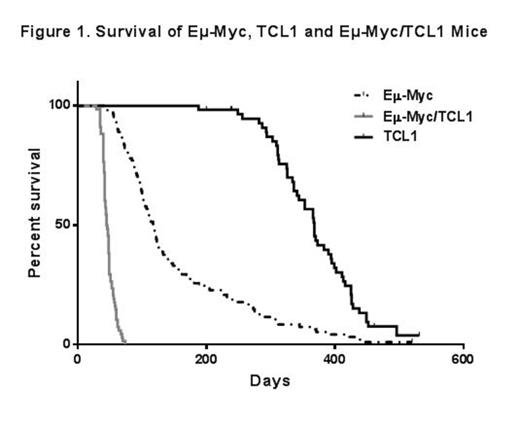Abstract
Background: Aggressive B-cell lymphomas occurring in the setting of Chronic Lymphocytic Leukemia (CLL) as a large cell transformation are an important clinical problem, and improved mouse models to test novel and targeted therapeutics are needed. The Eµ-Myc mouse overexpresses c-Myc gene which is placed under control of the Myc promoter and lymphoid-specific IgH enhancer (Eµ), resulting in c-Myc overexpression and spontaneous B-cell lymphoma development. The Eµ-Myc mice have been used in drug development, however malignancy develops at variable ages and with differing genetics and response to therapeutic agents, making drug studies difficult. The Eµ-TCL1 transgenic mouse overexpresses the human TCL1 oncogene, under the control of the B-cell specific IgVH promoter and Eµ enhancer. Mice develop a spontaneous mature B-cell leukemia after a long latency period and represent a well-established model of human CLL. We crossed the Eµ-Myc and TCL1 mice to create a new model of aggressive B-cell lymphoma to test novel therapeutics that would be more homogeneous than the Eµ-Myc model.
Methods: Eµ-Myc and TCL1 mice on C57BL/6 background strain were crossed and resulting genotypes were verified by PCR. All mice were kept in standard pathogen-free housing until death or removal from study. All mice born within a 24 month time period were followed for survival. At the time of death, spleen, lymph nodes, bone marrow, and liver were fixed in 10% neutral buffered formalin, embedded in paraffin, sectioned at 4uM, and stained with hematoxylin and eosin for histologic evaluation. For engraftment studies, adoptive cell transfer was done by injecting fresh splenic white blood cells (1e7 cells, >75% CD5+/CD19+) into the tail vein of C57BL/6 wild type recipient mice. In the drug treatment experiments ibrutinib (~30mg/kg/day) was administered in drinking water and KPT-8602 (15mg/kg) by daily oral gavage. Survival was shown using Kaplan-Meier curves and survival curves compared statistically using a log-rank test.
Results: The Eµ-Myc/TCL1 mice had significantly worse survival (median 45.5, range 29-74 days) compared to Eµ-Myc (median 118, range 42-520 days) or TCL1 (median 359.5, range 188-531 days) mice (p=<0.0001). Survival curves are show in Figure 1. Pathologic examination revealed aggressive B-cell histology similar to Burkitt lymphoma in both the Eµ-Myc mice and Eµ-Myc/TCL1 mice, whereas the TCL1 mice showed mature B-cell morphology. Infiltration of the bone marrow of Eµ-Myc and Eµ-Myc/TCL1 mice was extensive in comparison with TCL1 mice. In all three mouse genotypes the normal architecture in the spleen was effaced by neoplastic cells. Adoptive transfer of Eµ-Myc/TCL1 splenic lymphocytes produced similar pathologic findings to the Eµ-Myc/TCL1 transgenic mice with less severe splenic enlargement in the engrafted mice. Median survival of the engrafted mice was short (38 days). There was a differential response to targeted therapeutics between the groups. Ibrutinib, an irreversible inhibitor of Bruton tyrosine kinase (BTK) previously demonstrated to improve survival in TCL1 mice, had no survival advantage over vehicle treatment in either Eµ-Myc or Eµ-Myc/TCL1 mice (p=0.876 and P=0.83 respectively). KPT-8602, a second generation selective inhibitor of exportin 1 (XPO1) was tested in Eµ-Myc/TCL1 engrafted mice, and demonstrated a significant improvement in survival compared to vehicle alone (p=<0.0001). A first generation agent (selinexor) targeting XPO1 is currently in human clinical trials for aggressive lymphomas, including large cell transformation of CLL.
Conclusions: Mice with both c-Myc and TCL1 transgenes develop an aggressive B-cell malignancy and have decreased survival compared to Eµ-Myc or TCL1 mice. The histology of the disease is similar to that of Eµ-Myc mice, but with shorter survival with less variability. The resulting mouse model has differential responses to targeted therapeutics, with a poor response to ibrutinib more similar to aggressive lymphoma than CLL. The malignant B cells can be adoptively transferred into immunocompetent mice for experimental drug treatment studies. These qualities make Eµ-Myc/TCL1 mice a useful tool to test new therapies for aggressive lymphoma where there is an unmet clinical need. Work is currently underway to further define the genetic characteristics of this mouse in comparison to human lymphoma sub-types and responsiveness to targeted agents.
Byrd:Acerta Pharma BV: Research Funding.
Author notes
Asterisk with author names denotes non-ASH members.


This feature is available to Subscribers Only
Sign In or Create an Account Close Modal